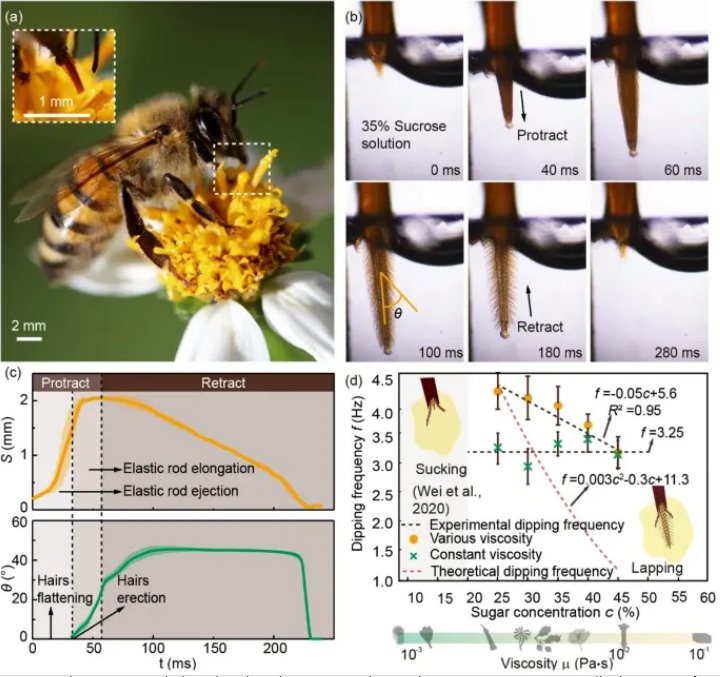引文信息:
Caiying Liao, Jiangkun Wei, Yichen Lan, Zhigang Wu, Chengpei Tang & Jianing Wu .An Origami-Like Sheath of a Honeybee Tongue for Fluid Viscosity Sensing. Journal of Bionic Engineering,2023,20(6),2764- 2773.
An Origami-Like Sheath of a Honeybee Tongue for Fluid Viscosity Sensing
Caiying Liao, Jiangkun Wei, Yichen Lan, Zhigang Wu, Chengpei Tang & Jianing Wu
1 School of Aeronautics and Astronautics, Shenzhen Campus of Sun Yat-Sen University, Shenzhen, 518107, China
2 School of Advanced Manufacturing, Shenzhen Campus of Sun Yat-Sen University, Shenzhen, 518107, China
3 Shenzhen College of International Education, Shenzhen, 518107, China
Abstract
Mechanoreceptors play a vital role for animals to sense and monitor environmental parameters, like flow speed, tactile resistance, and pressure. The hairy-structured trichoid sensillum, a common type of mechanoreceptor in insects, is generally non-motile, embedded in a socket connected with cuticular substrate. However, we discover that the trichoid sensilla on the tongue of western bees (Apis mellifera L.) is rotatable and can be actively maneuvered by bees. The trichoid sensilla together with the socket base are mounted on the origami-like sheath of the tongue, and can rotate outwards along with the deformation of the tongue sheath. We illustrate that the rotation of the tongue sensilla hairs can locally generate shear force in the liquid to sense the viscosity, which may facilitate bees to adjust their feeding strategies. The viscosity sensitivity of the rotatable trichoid sensilla based on the origami-like mechanism, according to our mechanical model, is 13 times greater than that of the fixed sensilla. In addition, our finite element analysis shows that strain would concentrate on the trichoid sensilla base when rotating in the liquid, which may structurally enhance its perception sensitivity. This study reports a new mechanism of active mechanoreceptors and may have implications for origami mechanisms with correlative functional components, especially for micro-robotic systems used in underwater viscosity sensing.

Fig. W1 Feeding cycles and adjusting feeding frequency of the honey bee (Apis mellifera L.) tongues. a A honey bee foraging nectar inside the corollas of a flower (Bidens pilosa L.). b High speed images of a bee dipping 35% (wt./wt.) sucrose solution. c Tongue displacement and average glossal hairs angle with respect to time when honey bees licking the 35% (wt./wt.) sucrose solution. d Regulation in dipping frequency concerning sucrose solution viscosity. The orange points and green crosses represent dipping rates of honey bees when imbibing sucrose solutions with various or constant viscosities. A range of nectar sources on the color bar with various viscosities, from left to right are box elder, Rhodophiala mendocina, Desfontainia spinose, Mutisia decurrens, Berberis darwinii, Oenothera odorata, Escallonia rubra, and saturated sucrose solution, respectively.

Fig. W2 Microstructure of a bee tongue. a The mouthparts consist of a pair of labial palps, a pair of galeae, and a hairy glossa. b SEM image of the honey bee tongue with sheath partially peeled off. c SEM images of the cross section of the tongue showing the origami-like units. d Trichoid sensilla with a ball-socket joint distributed on the origami-like units. e TEM image shows trichoid sensilla orientating on the base of origami-like units. f Cross section of the elastic rod.

Fig. W3 Modeling of a trichoid sensillum with tongue deformations. a Deformability tests of glossal hairs when the tongue is stretched. b Schematic plots of hair erection angle with origami-structure tongue length. c Sensory mechanism of the trichoid sensillum. d Simplified mathematical modeling of origami-like tongue reducing to a compliant segment with torsional compliant spring through the pseudo-rigid-body model approach. e Origami mechanism model (OMM) of a trichoid sensillum subject to viscous drag due to rotation in fluid at a velocity of v. f Hypothetical structure model (HSM) of a trichoid sensillum arranged in a fluid flow at a velocity of vh.

Fig. W4 Simulated and numerical analysis. a A three-dimensional representation of two origami segments of a honey bee tongue. b Schematic diagram of the model with origami mechanism. The proximal edge of the model was fixed, and assigned velocity as the same as elastic rod motion was distributed on the distal edge along the y-axis. c Tension force added at origami mechanism and the output velocity of sensillum hair in the origami mechanism model. d In the hypothetical case simulation, the whole structure is fixed except for the sensillum hair, subjected to the external flow of viscous fluid. e Finite element analysis of origami mechanism and hypothetical model, respectively. f Stress distributions on hairs in two models.
Information Publisher: Caiying Liao, Jiangkun Wei, Yichen Lan, Zhigang Wu, Chengpei Tang & Jianing Wu
Information Release Unit: School of Aeronautics and Astronautics, Shenzhen Campus of Sun Yat-Sen University
Information Source: https://rdcu.be/dqhP6

